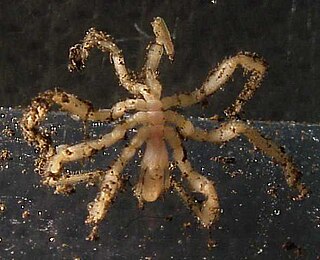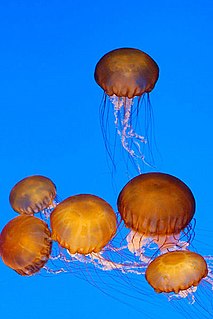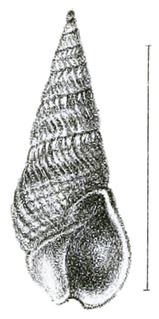
Sea spiders, also called Pantopoda or pycnogonids, are marine arthropods of class Pycnogonida. They are cosmopolitan, found in oceans around the world. There are over 1300 known species, with a leg span ranging from 1 mm (0.04 in) to over 70 cm (2.3 ft). Most are toward the smaller end of this range in relatively shallow depths; however, they can grow to be quite large in Antarctic and deep waters.

Titanosaurus is a dubious genus of sauropod dinosaurs, first described by Lydekker in 1877. It is known from the Maastrichtian Lameta Formation of India.
In zoological nomenclature, a nomen dubium is a scientific name that is of unknown or doubtful application.
Dinodocus is the name of a genus of sauropod dinosaur, named by Richard Owen in 1884. The name is now usually considered a nomen dubium. The only species, D. mackesoni, a name given to some fossil limb bones from the Lower Greensand of Kent, England, was formerly placed in the genus Pelorosaurus, but review by Upchurch et al. (2004) concludes that Dinodocus is a nomen dubium.
Mandschurosaurus is a genus of hadrosaurs based on material from the Upper Cretaceous of Belye Kruchi, Manchuria.
Diclonius is a genus of dinosaur from the Late Cretaceous. It was a hadrosaur based solely on teeth. Its fossils were found in the Judith River Formation of Montana, northern US. The name is in reference to the method of tooth replacement, in which newly erupting replacement teeth could be in functional use at the same time as older, more worn teeth. Thus, the number of "sprouting" teeth was doubled in comparison to Monoclonius, which used only one set of teeth at a time and which Cope named in the same paper.

Chrysaora is a genus of jellyfish in the family Pelagiidae. The origin of the genus name Chrysaora lies in Greek mythology with Chrysaor, brother of Pegasus and son of Poseidon and Medusa. Translated, Chrysaor means "he who has a golden armament."

Trifolium dubium, the lesser trefoil, suckling clover, little hop clover or lesser hop trefoil, is a flowering plant in the pea and clover family Fabaceae. This species is generally accepted as the primary plant to represent the traditional Irish shamrock.
Polychaos dubium is a freshwater amoeboid and one of the larger species of single-celled eukaryote. Like other amoebozoans, P. dubium moves by means of temporary projections called pseudopods. P. dubium reportedly has one of the largest genome size of any organism known, though the authors of a 2004 study suggest treating that measurement with caution.

The grosbeak starling, also known as the grosbeak myna, finch-billed myna, or scissor-billed starling, is a species of starling in the family Sturnidae. It is monotypic in the genus Scissirostrum. It is endemic to Sulawesi, Indonesia.
Fusus is a genus of small to large sea snails, marine gastropod mollusks in the family Fasciolariidae, the spindle snails and tulip snails.

Bullia is a genus of sea snails, marine gastropod mollusks in the family Nassariidae, the Nassa mud snails or dog whelks.

Trionyx is a genus of softshell turtles belonging to the family Trionychidae. In the past many species in the family were classified in this genus, but today T. triunguis, the African or Nile softshell turtle, is the only extant softshell still classified as Trionyx. The other species still assigned to this genus are only known from fossils. T. triunguis is a relatively large, aquatic piscivore.
Protonarthron is a genus of longhorn beetles of the subfamily Lamiinae, containing the following species:
Protonarthron gracile is a species of beetle in the family Cerambycidae. It was described by Stephan von Breuning in 1936.
Protonarthron indistinctum is a species of beetle in the family Cerambycidae. It was described by Stephan von Breuning in 1938. It is known from the Democratic Republic of the Congo.
Protonarthron diabolicum is a species of beetle in the family Cerambycidae. It was described by James Thomson in 1858.
Protonarthron microps is a species of beetle in the family Cerambycidae. It was described by Jordan in 1903.
Protonarthron olympianum is a species of beetle in the family Cerambycidae. It was described by Per Olof Christopher Aurivillius in 1913.
Protonarthron subfasciatum is a species of beetle in the family Cerambycidae. It was described by Jordan in 1894.







